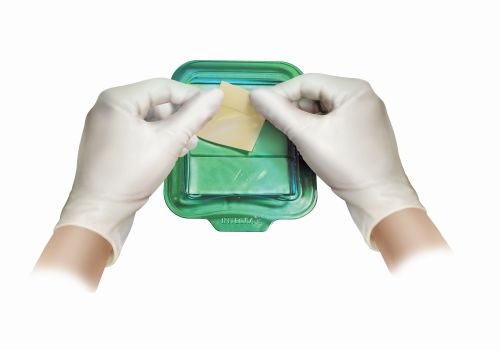
Integra® Omnigraft™ Dermal Regeneration Matrix
Integra® Omnigraft™ Dermal Regeneration Matrix is an advanced bilayer matrix for dermal regeneration. The dermal replacement layer consists of a porous, three-dimensional matrix comprised of bovine collagen and chondroitin-6-sulfate that is designed with controlled porosity and defined degradation rate. The temporary epidermal layer is made of a thin silicone layer to provide immediate wound coverage and control moisture loss from the wound.

Integra LifeSciences Corp.
Integra LifeSciences, a world leader in medical technology, is dedicated to limiting uncertainty for surgeons so they can concentrate on providing the best patient care. Integra offers innovative solutions in orthopedic extremity surgery, neurosurgery and reconstructive and general surgery.Benefits
• Supported by two decades of proven clinical excellence
• FDA approved for the treatment of diabetic foot ulcers
• Temporary epidermal layer
Indications
Integra® Omnigraft™ Dermal Regeneration Matrix is indicated for use in the treatment of partial- and full-thickness neuropathic diabetic foot ulcers that are greater than six weeks in duration, with no capsule, tendon or bone exposed, when used in conjunction with standard diabetic ulcer care.
Contraindications
Omnigraft™ should not be used in patients with known sensitivity to bovine collagen or chondroitin materials. Omnigraft™ should not be used on clinically diagnosed infected wounds.
Warnings and Precautions
Debridement or excision must be done thoroughly to remove any remaining necrotic tissue that may delay healing or cause infection. Omnigraft™ will not incorporate into a wound bed of nonviable tissue. Leaving any remaining nonviable tissue may create an environment for bacterial growth.
The following complications are possible with the use of wound treatments. The product should be removed if any of these conditions occur: infection, chronic inflammation (initial application of wound products may be associated with transient, mild, localized inflammation), allergic reaction, excessive redness, pain or swelling.
Do not re-sterilize. Discard all opened and unused portions of Omnigraft™.
Omnigraft™ is sterile if the package is unopened and undamaged. Do not use if the package seal is broken.
Discard Omnigraft™ if mishandling has caused possible damage or contamination.
There have been no clinical studies evaluating Omnigraft™ in pregnant women. Caution should be exercised before using Omnigraft™ in pregnant women. Such use should occur only when the anticipated benefit clearly outweighs the risk.
Do not use enzymatic debridement agents when cleaning out the wound.
Omnigraft™ should be applied on the day of debridement. Delaying the application of Omnigraft™ may substantially impair the take of the material to the wound bed.
Hemostasis must be achieved prior to applying Omnigraft™. Inadequate control of bleeding will interfere with the incorporation of Omnigraft™.
Appropriate bolstering techniques should be used so Omnigraft™ maintains intimate contact with the wound bed.
Keep the dressings dry and avoid contact with water at all times.
Omnigraft™ must NOT be excised off the wound.
Caution must be employed to not remove the newly formed dermal tissue when removing the silicone layer.
Placing the patient in hydrotherapy immersion may interfere with proper incorporation of Omnigraft™ and cause premature separation of the silicone layer and non-adherence to the wound bed.
Appropriate offloading techniques to minimize pressure and shearing should be used to reduce the risk of mechanical dislodgement.
Adverse Effects/Reactions
See Instructions for Use.
Storage Requirements
Room temperature, six month shelf life.
How Supplied/Sizing
HCPCS Code
Product features
Other features
Recommended Use
Diabetic Foot
Mode of Use/Application
Sharp Debridement
Using aseptic technique, prepare the wound bed using standard methods to ensure the wound is free of debris and necrotic tissue.
Sharp debridement must be made to the level of viable tissue. Meticulous hemostasis needs to be achieved to prevent hematomas or excessive fluid accumulation. Omnigraft™ should not be applied over infected or deteriorating wounds until the underlying issue has been resolved.
Cleansing
Cleanse the wound thoroughly using a neutral, non-irritating and non-toxic solution such as sterile saline or sterile water.
Product Preparation
To minimize the risk of infection, change your gloves following debridement and cleansing and before handling Omnigraft™. A fresh set of sterile instruments are required for Omnigraft™ placement, shaping and cutting.
Using aseptic technique, remove the outer tray from the box and peel open the foil lid. Remove the inner tray and place it on a flat, sterile surface. Peel open the foil lid and discard the green plastic retainer.
Rinse the product with a sterile saline solution in the inner tray for at least two minutes. Keep product in the tray until application. When ready to apply the product, remove the product from the tray and peel off the protective plastic sheets.
NOTE: Before the application, Omnigraft™ can be pie crusted.
Pie crusting may improve the ability of the matrix to conform to irregular surfaces and may improve contact with the wound bed.
Remove plastic sheets prior to pie crusting the silicone layer.
Product Application
Trim Omnigraft™ to size and apply immediately following wound bed preparation. The product should overlap the edges of the wound by 2mm. Any air bubbles should be carefully removed by moving them to the edge of the sheet using a gentle rolling motion to achieve intimate contact with the wound bed.
NOTE: It is critical that the collagen layer be in direct contact with the prepared wound bed. The silicone layer, identified by the black threads, must be placed away from the wound bed. Do not apply upside down; the black threads must be clearly visible. The black threads do not have to be placed in a certain orientation.
Omnigraft™ should be firmly secured using surgical staples or sutures so the product maintains intimate contact with the wound bed.
Appropriate bolstering may be used so Omnigraft™ maintains intimate contact with the wound bed.
After bolstering, use appropriate dressings to maintain product adherence and protect the wound area. The optimum secondary dressing is determined by wound location, size, depth and user preference.
Post Application Care
Clinicians should change the dressings weekly without disturbing Omnigraft™. Frequency of dressing changes will be dependent upon the volume of exudate produced, the type of dressing used and the clinician's need to inspect the wound bed for signs of infection or healing.
NOTE: Ensure that Omnigraft™ maintains intimate contact with the wound bed at all times. Be careful not to disturb Omnigraft™.
NOTE: Use a 15 blade scalpel to make an incision if hematoma or excess exudate exists.
Use an offloading device for patients following the application of Omnigraft™ to reduce shearing forces and to protect the wound site from future re-injury, especially on the plantar aspect of the foot.
Removal & Change Frequency
Removal of Silicone Layer
If the edges of the silicone layer have separated from the wound site, the separated silicone can be trimmed.
NOTE: The silicone layer of Omnigraft™ may be removed when the collagen layer has been replaced by neodermis, usually 14 to 21 days after application.
The clinician must be careful when removing the silicone layer. The silicone layer can usually be removed using only forceps. Generally, it should peel off easily. Difficulties in removal may indicate that the neodermis formation is incomplete.
Caution: Do not remove the newly formed neodermal tissue when removing the silicone layer. Omnigraft™ must not be excised off the wound.
Caution: If bleeding occurs, or if patient complains of excessive pain, stop and wait one to two additional days. Forced removal may result in wound re-injury.
NOTE: It is recommended to always offload the ulcer until the wound has closed. To minimize recurrence, continue to offload to prevent future re-injury per the treating clinician's protocol.
Additional Recommended Dressings
Change secondary dressings as needed. Frequency of secondary dressing change will be dependent upon volume of exudate, type of dressing and the clinician's need to inspect the wound bed.
No posters match your selected filters. Remove some filtres, or reset them and start again.
Have a product to submit?
Be included in the most comprehensive wound care products directory
and online database.
Learn More












Follow WoundSource
Tweets by WoundSource